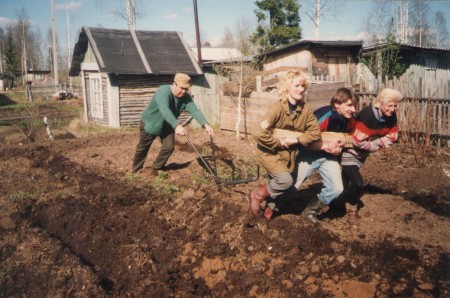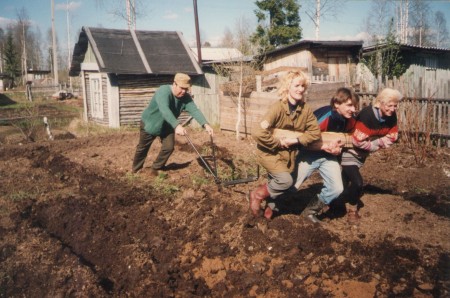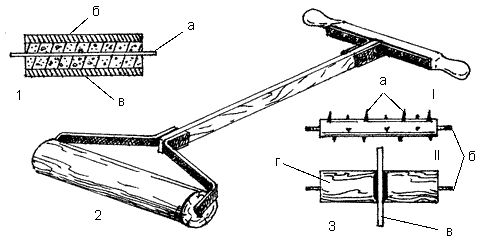The saying “Sow in the mud, you will be a prince” calls for hastening with sowing, but it can be impossible to dig cold, moisture-saturated soil early in the spring. Just wait a little, and digging won't seem like a punishment.
When to start sowing?
The readiness of beds for cultivation and sowing greatly depends on the weather, location of the site, terrain and soil composition.The soil should dry out, but not dry out. The soil that is ready for cultivation does not stick to the shovel, it crumbles into several parts, and the filter paper pressed to it does not get wet. Dried soil crumbles into small pieces.
The soil on the southern slope ripens ten days earlier than on the northern slope, on a flat area or in a lowland. Sandy and sandy loam soils dry out faster.
As soon as the soil dries slightly, it is necessary to “close” the moisture in the areas dug up in the fall: loosen the top layer to a depth of 5-6 cm.
On light or well-cultivated soils, digging is replaced by loosening with a fork, cultivator or miracle shovel to a depth of 10-12 cm.
Preparing the beds
All dug up beds are immediately rake to conserve moisture and maintain soil structure.
For spring cultivation of the land, nitrogen fertilizers are applied, for example, a teaspoon of ammonium nitrate per square meter. m. Phosphorus-potassium fertilizers can also be applied if they were not added to the soil during autumn digging.
The spring wind will quickly blow away moisture from the upper layers of soil, especially freshly dug soil. And the smaller the gap between digging up the soil and sowing seeds (planting tubers), the more moisture the seeds and young plants will get.
When cutting seed furrows in the beds, you must try to keep them even. It is best to mark them with a special board along the cord. In this case, the board will compact the bottom of the furrow, the seeds will fall into the ground at the same depth, water from the lower layer of soil will be evenly drawn to the seeds, and the seedlings will be amicable.
Why do you need a roller on the beds?
After sowing, the soil surface must be lightly “slammed” with a hoe or rake to ensure an influx of moisture from the lower layers and uniform and rapid emergence of seedlings.
It is more correct to replace “slamming” with rolling, making a wooden roller for this - once for many seasons to come. A piece 12-15 cm long is cut from a pine log with a diameter of about 15 cm.
Then a through hole with a diameter of 12-15 mm is drilled in the center of the log (from the end) and a thick wire rod is inserted into it and bent to form an axis and handles. Having connected them together, weld a tube to the handles and insert the handle into it.
For strength, stepping back a centimeter from the edges, 3 cm apart from each other in a checkerboard pattern, 10-centimeter nails without heads are driven into the roller for strength to a depth of 5 cm. The ripper roller is ready.
After sowing and rolling, the bed is covered with film or non-woven material, pressing the edges tightly against the sides. Under the film, the soil warms up better, but in sunny, warm weather, the emerging seedlings under it can become steamy.
And if you are rarely on the site, it is better to cover the beds with non-woven material. It will provide shade from the scorching rays of the sun, prevent the soil from cooling quickly at night, protect against frost, and prevent moisture from evaporating.
You might be interested in:




 CUCUMBERS NEVER GET SICK, I'VE BEEN USING ONLY THIS FOR 40 YEARS! I SHARE A SECRET WITH YOU, CUCUMBERS ARE LIKE THE PICTURE!
CUCUMBERS NEVER GET SICK, I'VE BEEN USING ONLY THIS FOR 40 YEARS! I SHARE A SECRET WITH YOU, CUCUMBERS ARE LIKE THE PICTURE! You can dig a bucket of potatoes from each bush. Do you think these are fairy tales? Watch the video
You can dig a bucket of potatoes from each bush. Do you think these are fairy tales? Watch the video
 How our fellow gardeners work in Korea. There is a lot to learn and just fun to watch.
How our fellow gardeners work in Korea. There is a lot to learn and just fun to watch. Eye trainer. The author claims that with daily viewing, vision is restored. They don't charge money for views.
Eye trainer. The author claims that with daily viewing, vision is restored. They don't charge money for views. A 3-ingredient cake recipe in 30 minutes is better than Napoleon. Simple and very tasty.
A 3-ingredient cake recipe in 30 minutes is better than Napoleon. Simple and very tasty. Therapeutic exercises for cervical osteochondrosis. A complete set of exercises.
Therapeutic exercises for cervical osteochondrosis. A complete set of exercises. Which indoor plants match your zodiac sign?
Which indoor plants match your zodiac sign? What about them? Excursion to German dachas.
What about them? Excursion to German dachas.